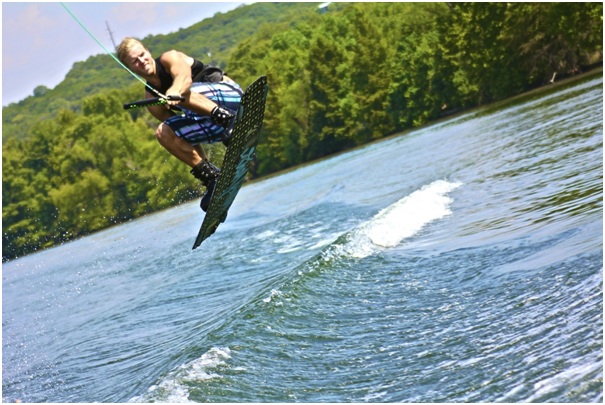Nearly 95% of Americans live within an hour’s drive of water where they can paddleboard, surf, and wakeboard.The latter has boomed in popularity as it lets you bond with loved ones, enjoy a fantastic workout, and boost your mood. Perhaps you’re eager to try wakeboarding, but you’re unsure where to start.Sounds familiar? Don’t worry, we’ve got your back. Here are the top Wakeboarding Tips for beginners.
- Always Wear the Right Equipment
Before you learn how to get up on a wakeboard, you need to find the right gear.
Wakeboards come in an array of sizes but beginners should choose a longer one to improve their stability and buoyancy. To check whether it’s the right size, stand next to it as it’s held upright. If the nose is in level with your chin, then you’ve got a keeper. Also, it’s wise to rent a board until you get a feel for the sport because wakeboards can be expensive.
You’ll also need a jacket for safety, so slip it on, buckle it up, and make sure you can’t lift the shoulders above your ears, otherwise, it’s not tight enough.
- Decide Whether You’re Goofy or Regular
You’ve got your wakeboarding equipment, so now you must answer the burning question: Are you regular or goofy?
Goofy is when your right foot is forward on the board while regular means your left foot is. If you’re unsure where you fall, consider which foot you naturally use to kick a soccer ball, and that will be your back foot on the wakeboard.
- Choose Your Method of Learning
On your quest to learn how to wakeboard, figure out whether you want to attend wakeboard school for a group lesson. This is so a professional can teach you how to use the equipment and fall safely.
You can also visit cable parks as you get a better vertical lift than being towed by a boat, which is perfect for a wakeboarding beginner. If you’re struggling, choose a 2.0 system cable park because they go back and forth in a straight line so you can learn how to balance better.
During this time, you must learn hand signals so you can communicate with the spotter who watches you from the boat. You’ll learn that a thumbs-up signals “accelerate speed”, whereas a thumbs-down shows you want to go slower.
Note, the maximum speed the boat should go is 19 miles per hour as wakeboarders require less when being pulled.
- Look Before You Move
One of the top wakeboarding for beginners is to look straight ahead as you move. Although it’s mesmerizing watching your board sail across the water, you’ll subconsciously place more weight on your front foot as you do this, thereby affecting your balance.
If you’re struggling to look ahead, watch the spotter or focus on the horizon instead.
- Use a Short Rope
Short ropes are a wakeboard beginner’s best friend because they help you balance. They also ensure you stay in the wake’s narrower portion while you listen to the instructor’s advice. As a general rule, beginners should use a rope between 30 and 50 feet wide.
Further, it’s an instinct to yank the rope to gain balance, but you must rely on the boat to pull yourself back up. If you tug, then the wakeboard’s nose may sink into the water, bringing you along with it.
- Be Prepared to Fall
Before you set one foot on that board, accept that you are going to fall. It’s part of the learning experience and the key to finding your balance. But luckily, once you grab the latest watersports products and practice for several hours, you’ll understand the basics.
Know, hitting the water feels like doing a belly flop in a swimming pool, so mentally prepare yourself for it.
- Learn the Basic Tricks
In wakeboarding, there is a huge variety of tricks to try. To start, when you’re comfortable getting up, learn how to cross the wake.
As you’re riding along, turn your shoulders to face the boat then bring the handle inwards, from your front hip to the inside. Make sure you contribute your weight evenly onto your heels so you glide across the surface.
The next stick is to jump the wake.
To do this, start 30 degrees from the outside and roll into the edge. As you do this, keep your entire body rigid so you don’t absorb the wake’s power, otherwise, you’ll get kicked off. You should also keep the handle at your waistline so you stay balanced.
Another basic trick is an ollie, where you don’t use the wake to launch you. To do this, jump on the wakeboard’s tail to compress the water, and raise your front foot upwards. The force will push against your board so you pop out of the water. Note, the harder you push, then the higher you’ll jump.
Once you’ve mastered the ollie, try a tail grab.
This is where you grab the tail of your wakeboard with your backhand. You can make this trick easier by pushing down harder on the board, just before you pop. When you do this, you level out mid-air so it’s easier to grab the tail.
Those Are the Top Wakeboarding Tips for Beginners
Hopefully, after reading this article, you understand the top wakeboarding tips for beginners.
Make sure you rent high-quality gear, take lessons or visit a cable park, and accept that you’re going to fall. Although it’s challenging at first, keep practicing these basic tricks, and you’ll be a wakeboarding pro in no time. Good luck!
Did you find this article helpful? Great! Then check out our other sports-related posts.















